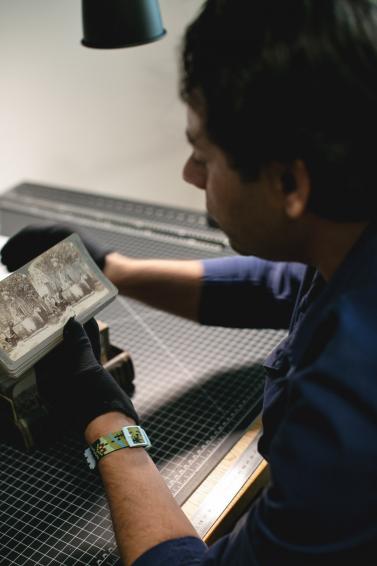In The Studio: Hazem Harb

The Palestinian Visual Artist shares insight into the rarified archives that shape his art
Words by Laura Beaney in The Lifestyle · Jul 14th, 2021
Hazem Harb’s art is present among some of the most impressive personal and public collections of contemporary Middle Eastern art and can be encountered internationally in institutions from the British Museum, London to Centre Pompidou, Paris. What sets Harb’s artistic practice apart is his inclusion of rarified ephemera - archival photographs, coins and maps - which the artist understands as powerful materials that can counter dominant narratives surrounding Palestinian histories and identities. Harb harnesses these items, re-framing them in a contemporary art context so that his audiences might understand the Palestinian experience in a more nuanced and intimate way. For this edition of ‘In The Studio’ we enter the artist’s tranquil Jumeirah sanctuary to uncover the motivations behind his socially-driven art and to share a privileged glimpse into his archives, collected and contributed to over several decades.
What brought you to Dubai and why was the community appealing to you as an artist?
I’m originally from Gaza but moved to Dubai in 2013 upon completion of my education in Rome, Italy. As a Palestinian the UAE has long formed a safe and welcoming space for my people and I was delighted to encounter a community of artists, practitioners and galleries that comprised individuals of a similar mindset as well as those from diverse social contexts that I could learn from. It’s here that I’ve met certain individuals that have an intimate understanding of what I do and have propelled me to achieve international attention. The gallery I’m represented by, Tabari Artspace, is led by a strong Palestinian female force, Maliha Tabari, and through our collaborations in the art world we’ve been able to put forward lesser-known perspectives and challenge the status quo.
Tell us about your creative environment.
I’ve lived in Umm Suqeim for several years with my studio and home in the same space, it’s my haven. I find Umm Suqeim, just a street back from the sea, to be one of the more peaceful parts of the city, enriched by plant life, calm residents and a mellow, beach-side pace of life. It’s also where I came to discover my two cats - stray ginger tabbies, Bello and Carina, found abandoned at the side of the street - they’ve come to form part of my family. I moved to my new studio in the same area a few weeks ago. My mahogany brown, modernist armchairs, the soft morning light that filters in through the windows, the sound of the call to prayer ringing out from the neighbourhood mosque, my trailing ferns and texts by Edward Said and Mahmoud Darwish make this space a home.
How do Palestinian archival materials shape your art?
My archives include coins, maps, personal and collected photographs and other materials that date back to 19th century Palestine. These objects are deeply influential and integral to my art. I remediate my materials through a contemporary approach, transforming them into new assemblages so that they might take on new and continuously relevant meanings. I work across multiple mediums from installation to collage, film, and incorporate experimentation with manual processes such as etching - my approach is always conceptually driven.

My art is a continuous enquiry, which I approach through various lenses, I've previously taken the boundaries plotted on maps, architecture and regional embroidery as devices through which to understand processes of colonisation and repression.


And why are these materials so important to you?
For me, the reintroduction of these old artefacts into the present is crucial as they act as evidence. My process saves them from being glossed over or eliminated altogether by those that frame the narrative. My most recent acquisition that you can see here dates back to 1882 - a first edition Bible encompassing illustrations of the ‘Holy Land’ sourced from America. When I travel I scour antique markets to find these objects, and as my art has become more internationally recognised Palestinian families have begun to donate photographs and materials for me to remediate so that can preserve and extend the dialogue of their family through my art. It’s quite a responsibility to present these intimate visual records in a way that’s meaningful.



What can we learn from your art?
My art is a continuous enquiry, which I approach through various lenses, I’ve previously taken the boundaries plotted on maps, architecture and regional embroidery as devices through which to understand processes of colonisation and repression. I’ll share some examples. The works hung here in my studio were produced this year and are part of the series: Survey For a Colonial Map, 2021. These pieces use an early map of Palestine (published in 1883) to contest the erasure of cultural narratives, territories and information that are often enabled by our institutions and systems of knowledge. In the Bauhaus as Imperialism series, 2019 I took architectural shifts and the imposition of concrete Bauhaus on Palestinian pastoral lands and historical sites to illuminate the weight and multifaceted nature of oppression. For another work, The Silk Line of Identity, 2020, I used traditional Palestinian dress as a vehicle through which to explore gendered, regional and cultural specifies. Palestinian traditional women’s dress is fascinating to me. The embroidery patterns are unique to a particular community and the specificity us such that a Palestinian woman's village could be determined by the embroidery design on her dress. The design in this diptych signifies Bethlehem and includes a digital manipulation of a photograph that was produced towards the end of the 1800s. Currently, I’m busy working on my forthcoming solo exhibition at the Maraya art centre in Sharjah.
You can view Hazem’s work displayed at Reflections: Contemporary art of the Middle East and North Africa at the British Museum, London until August 15th, 2021.
w. www.hazemharb.com
Instagram: @hazemharb